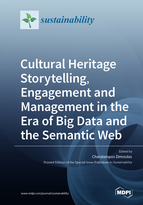Cultural Heritage Storytelling, Engagement and Management in the Era of Big Data and the Semantic Web
A special issue of Sustainability (ISSN 2071-1050).
Deadline for manuscript submissions: closed (30 June 2021) | Viewed by 43253
Special Issue Editor
Interests: media technologies; digital storytelling; audiovisual heritage; cultural heritage; signal processing; machine learning; media authentication; audiovisual content description and management automation; multimedia semantics; big data
Special Issues, Collections and Topics in MDPI journals
Special Issue Information
Dear Colleagues,
Cultural heritage (CH) refers to a highly multidisciplinary research and application field, intending to collect, archive, and disseminate traditions, monuments/artworks, and overall civilization legacies that have been preserved throughout the years of humankind. This effort is considered very important for historical and educational purposes, which can be deployed in schooling and training sessions, in science and social/humanistic studies, in artistic expression, and in everyday entertaining environments. Today’s digital media landscape offers innumerous ways for expediting the above processes at both ends, i.e., CH content production and “consumption”, taking advantage of the contemporary networking utilities with the associated augmented interaction capabilities. For instance, many museums and other art/cultural organizations are invested in the development of featured digital applications with appealing storytelling and their online dissemination to engage the audience in featured CH projects. Likewise, the proliferation of mobile devices and services and the vast expansion of so-called user-generated content (UGC) have fueled the digitization of personal CH artifacts and their progressive organizations in larger-scale databases. A typical example in that direction is the Europeana project, which formed specific media archiving and metadata standardization rules for CH institutions and sole users to follow. At the same time, urgent needs for better documentation and management of CH documents have emerged, making it difficult for the average user to be part of such large-scale undertakings.
Today, Semantic Web and Big Data technologies promise to facilitate more straightforward data analysis, information classification, semantic conceptualization, and management automation of multimodal content, which could also be applied for the benefit of sensitive CH sectors. Specifically, these automation layers could work as mediated communication and collaboration mechanisms between corporations and individuals to accelerate the proper launch, maintenance, and sustainability of suitable CH repositories, in favor of all the participants. For instance, many significant personal collections have not yet been detected, captured, fully restored, and documented (e.g., photos, films/movies, other private items, etc.). The development of sophisticated digital crowdsourcing procedures with the necessary technological/interdisciplinary cooperation and support would allow mining, shaping, and making available to the public such unique CH masterpieces. Thereafter, suitable engaging audience practices and models are welcomed to enhance the impacts of heritage initiatives, amplifying the environmental, cultural, economic, and social sustainability of human beings. The current call for papers (CfP) aims at further enlightening the above areas, inviting researchers to submit original/featured research works, related but not limited to the following multidisciplinary topics:
- Digital storytelling for cultural heritage;
- Audience engagement in cultural heritage;
- Sustainability impact indicators of cultural heritage;
- Cultural heritage digitization, organization, and management;
- Collaborative cultural heritage archiving, dissemination, and management;
- Cultural heritage communication and education for sustainable development;
- Art and cultural artifacts recognition;
- Semantic services of cultural heritage;
- Big data of cultural heritage;
- Smart systems for cultural heritage sustainability.
Assoc. Prof. Dr. Eng. Charalampos Dimoulas
Guest Editor
Manuscript Submission Information
Manuscripts should be submitted online at www.mdpi.com by registering and logging in to this website. Once you are registered, click here to go to the submission form. Manuscripts can be submitted until the deadline. All submissions that pass pre-check are peer-reviewed. Accepted papers will be published continuously in the journal (as soon as accepted) and will be listed together on the special issue website. Research articles, review articles as well as short communications are invited. For planned papers, a title and short abstract (about 100 words) can be sent to the Editorial Office for announcement on this website.
Submitted manuscripts should not have been published previously, nor be under consideration for publication elsewhere (except conference proceedings papers). All manuscripts are thoroughly refereed through a single-blind peer-review process. A guide for authors and other relevant information for submission of manuscripts is available on the Instructions for Authors page. Sustainability is an international peer-reviewed open access semimonthly journal published by MDPI.
Please visit the Instructions for Authors page before submitting a manuscript. The Article Processing Charge (APC) for publication in this open access journal is 2400 CHF (Swiss Francs). Submitted papers should be well formatted and use good English. Authors may use MDPI's English editing service prior to publication or during author revisions.
Keywords
- audience engagement
- cultural heritage
- digital storytelling
- big data
- semantic web
- digital management
- archiving
- crowdsourcing
- sustainability






